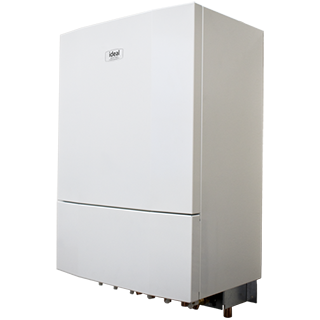Decarbonising heating and hot water in buildings is an existential challenge for our industry, but one solution that is set for a resurgence is district heating, or heat networks. This isthanks to the energy efficiencies that can be achieved and the scalability on offer in current district heating system technology and design. Charlie Mowbray, Commercial Product Manager, Groupe Atlantic UK, ROI & NA, explains more about the heating network and the role it can play on the pathway to net zero.
Around 500,000 UK properties are currently connected to district heating networks but the government’s Clean Growth Strategy predicts this could rise to more than five million by 2050. To help make this happen, £288 million has been committed to support the development of new district heating networks. This support comes through the Green Heat Network Fund (GHNF), which is open to the public, private and third sector and runs until 2025.
What is district heating and how does it work?
A district heating system delivers thermal energy in the form of hot water from a central source to end users using a network of insulated pipes. This heating network could be designed to serve a single block of flats or an entire city. Every district heating system has three main elements:
1. The energy centre sits at the heart of a heat network, heating the hot water that is distributed around the system. Although energy centres can use almost any heat source, to take advantage of the GHNF low carbon heat sources must be used.
2. The energy centre connects to the distribution network, the insulated pipes that deliver hot water to end users.
3. Each end user then has a Heat Interface Unit (HIU), like the Ideal Heating POD HIU, which transfers heat from the distribution network to the end user’s heating system or is used to generate instantaneous hot water. The Ideal POD HIU looks just like a domestic combi boiler from the outside and has similar controls, but instead of burning gas it uses heat exchangers to transfer thermal energy. This energy is transported from the hot water in the distribution network to the water in the property’s heating and hot water systems.
What are the advantages of a district heating system?
District heating is a flexible, tried and tested technology that has been safely and effectively heating homes around the world for more than a century.
Having a single heat source, the energy centre, can generate economies of scale and help the whole system operate more efficiently, in turn reducing carbon emissions. The versatility of district heating networks means they are suitable for all building types, from bungalows to high rise flats, businesses and public buildings, regardless of their age or fabric. In fact, a mix of different building types can be a benefit as demand for heat is spread through the day and year, so the system doesn’t experience sharp peaks in demand at certain times.
While district heating systems are typically used in high-density built-up areas such as city centres, they can also heat new build developments and campuses as well as off-gas communities in rural locations. In older housing stock, they are a practical option to retrofit because there is no need for flue routes or gas connections to individual properties. In all property types, they remove the need for gas checks along with the risks associated with gas and flues.
With foresight at the design stage district heating networks can be extended over time, adding new energy centres and end users, and separate networks can even be connected, increasing the impact and enhancing the economies of scale that can be achieved.
For end users, heat networks can achieve lower energy bills because a central energy centre can be more efficient than individual boilers in each property. The savings generated will depend on a range of variables from the type of system used to the type of property and how it was previously heated. However, the UK government suggests savings of at least 30 percent could be achieved when replacing electric heaters in tower blocks, for example. What’s more, the Scottish government forecasts annual fuel savings of around 20 percent for every household that connects to a district heating network. This is because systems like the Ideal POD HIU measures the amount of heating and hot water used so individual households can be billed according to the exact amount of energy they have consumed.
The impact on greenhouse gas emissions can be even more impressive. Veolia reports that the district energy heat network that it operates in Sheffield cuts carbon emissions by more than half. Further analysis by Devon County Council suggests that a plan to power a new development of 2,500 homes using district heating will reduce carbon emissions by up to 70 percent. Swedish energy firm Vattenfall’s also plan to build a district heating network in London serving 500,000 homes, powered by waste heat from recycling, data centres and water processing. This would reduce heat-related emissions from homes by up to 90 per cent.
Heating network solutions and the Ideal POD HIU
The UK is taking a slightly different approach to district heating than they have on the continent. There, water leaving the central energy centre may be up to 90C, whereas the drive in the UK is to have a maximum primary temperature of 70C. This gives greater cost and efficiency benefits as a wider range of heat sources can be used, from heat pumps to energy from waste, recovered geothermal energy and renewable energy.
Ideal Heating commercial has developed the POD HIU heating system specifically to suit these cost and energy efficient technologies, which comes in two models:
- POD Indirect is a twin plate appliance to provide complete separation from the heat network for both heating and hot water. Available in outputs of 30, 40, 50, 60 and 70kW.
- POD Direct is a single plate appliance, enabling heat from the network to directly heat the heating system and indirectly generates instantaneous Domestic Hot Water (DHW). Available in outputs of 30, 40, 50 & 60kW.
All the indirect Ideal POD heat interface units are BESA registered, having met the requirements of the BESA UK HIU Test Regime for both high and low temperature operating conditions.
The rapid roll out of district heating networks brings an exciting proposition on the pathway to net zero. To meet the needs of all who come into contact with POD HIU heating systems, from the end users who want a reliable and simple-to-use appliance to contractors and installers, our Ideal Heating development team has prioritised ease of install and servicing, availability of spares and the number of engineers to ensure the best possible experience.
Our first fix kit – which incorporates the service valves, appliance support and hanging bracket is supplied separately so it can be delivered and installed ahead of the POD unit so all services can be piped up, flooded, flushed, and tested in advance – enabling phased construction programmes and maximising productivity on site.
With over 100 years of experience providing high-quality heating solutions, we are committed to supporting the UK on its drive to net zero. We recognise the role we can play in helping to make that journey as easy as possible for contractors and installers, not just from the perspective of the devices we design but also the training we offer to ensure everyone can be upskilled in installation.
To find out more, see our Ideal POD HIU heating systems or contact Ideal Heating here. We have a range of commercial heating solutions and will be happy to assist you with your requirements.


